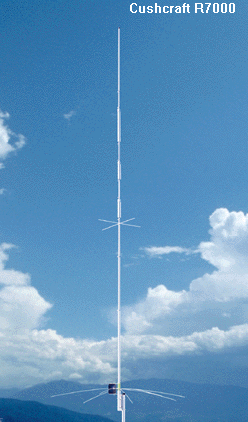
For several years; I was a severly ANTI-VERTICAL operator,believing that there was NO WAY a vertical actually works any better than a DUMMY LOAD in radio operations. Several hundred DX contacts later, I am now a believer in the value of the vertical for DX and in stealth radio operations.
I have utilized Cushcraft R7000 vertical at my location for about 10 years now; purchased used from a hamfest in Midland, TX. As purchased, this antenna gave me quite a few problems: intermittent SWR, frequent adjustments to correct bad swr,and an intermittent dead short situation on the 15m band.
The R7000 is mounted approximately 15ft above ground, on a short push up mast. Through trial and error, I discovered that this antenna seems to perform most optimally when not located directly on the ground.
I located the R7000 in the center of 6 large Oak trees in my backyard. This location afforded the best stealth operation; largely invisible from the adjacent neighbors. This is imporant since I operate in an Antenna restricted neighborhood; No antennas of any kind are permitted by the HOA. I did have to do a bit of tree trimming to clear an area of about an 8 foot radius around the antenna (from the crossed counterpoises to the top of the antenna). Before I cleared the tree limbs I was getting a very marginal 1.9 SWR that would jump to 2.0 or higher if it rained or the limbs were actually touching the radiating element. Now that the limbs are cleared I operate without any kind of tuner and the SWR stays below 1.5 on all bands 10m thru 40m. Close proximity of tree limbs and branches close to the top of the antenna affects SWR on the 30 and 40 meter bands.
Dead Shorts on 15M band:
This problem was traced to poor trap construction and factory quality control. Each antenna trap has two elements (10/12, 15/17, and 20/30). At the base of the 15/17 trap is an aluminum collar that is only riveted to the trap. I found that this collar was very loose and it needed tightened or replaced. I drilled out the rivet that bonded the collar to the rest of the trap and replaced with a stainless steel bolt, star washer, lock nut, and nut. I brushed the aluminum collar where it makes contact with the trap base and tightened the bolt assembly.
Varying SWR in different weather:
This was caused by the screws attaching the trap coil wires to the trap contact points. These screws loosen over time and form poor electrical contact with the trap body. I removed all of the original hexhead screws and increased to the next larger guage. This allowed the screws to be tightened much better. In addition, I placed aluminum star washers under the screw head next to the body and used aluminum lock washers under each screw head.